日本文化(英语介绍)
用英语介绍日本 Japanese Culture(超赞!力荐!)Japan

The Journey to
Introduction
Kimono
Food
Sakura Language
Kimono
Kimono(和服) is Japan’s national costume, the highly traditional Japanese culture for hundreds of years and the Japanese life closely linked. Even today, whenever there’s a holiday or a wedding, funeral, graduation ceremonies and celebrations such as a grand occasion, the Japanese kimono is still the first choice.
咖啡 コーヒー coffee 美国 アメリカ America 法国 フランス France 电子计算机 コンピューター computer
foreign words外来语
Language Grammar
I'll go to Japan. Subject Predicate Object(主谓宾)
私は日本に行きます。
Food
Food
Food
Food
Takoyaki
¥5yuan / 4
たこ焼き
Sakura
The national flower of Japan
Japan‘s Sakura blossoms every year from south to north sequence flowering, so the Japanese have a word called cherry front (樱花 前线)
英文版日本人文介绍
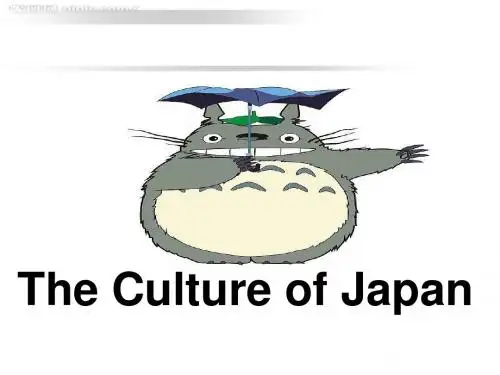
Eating a Meal Before eating, Japanese people say "itadakimasu," a polite phrase meaning "I receive this food." This expresses thanks to whoever worked to prepare the food in the meal. After eating, people once again express their thanks for the meal by saying "gochiso sama deshita," which literally means "it was quite a feast."
The word Geisha is derived from “Gei”, which in Japanese performance or entertainer, and “sha”, which means “person”, and dates back 400 years ago to the Edo period(江户 时代). During this period the Geisha entertained at banquets and social gatherings by playing Shamise(日本三弦琴), singing, and giving dance performances.
3Buckwheat ['bʌkwi:t] noodles荞麦 面条
• Buckwheat noodles or soba is also a typical Japanese dish. There are some people that eat soba at least once a day. Many office workers make it a habit to have soba for lunch. Soba noodles are a mixture of buckwheat, flour ['flauə] 面粉and eggs. It looks similar to spaghetti in shape. It is first boiled, and then dipped in a soup made of soy sauce, salt, sweet sake, and bonito[bə'ni:təu] shavings when it is being eaten. Because soba is long, it is considered a symbol of long life.
日本文化英语作文
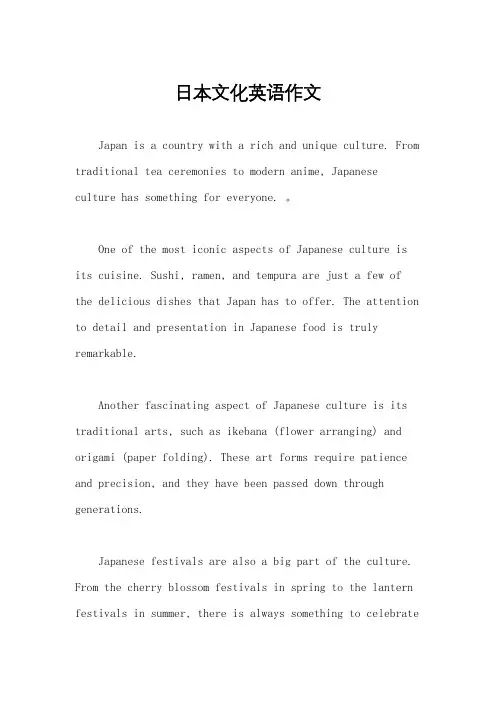
日本文化英语作文Japan is a country with a rich and unique culture. From traditional tea ceremonies to modern anime, Japaneseculture has something for everyone. 。
One of the most iconic aspects of Japanese culture is its cuisine. Sushi, ramen, and tempura are just a few of the delicious dishes that Japan has to offer. The attention to detail and presentation in Japanese food is truly remarkable.Another fascinating aspect of Japanese culture is its traditional arts, such as ikebana (flower arranging) and origami (paper folding). These art forms require patience and precision, and they have been passed down through generations.Japanese festivals are also a big part of the culture. From the cherry blossom festivals in spring to the lantern festivals in summer, there is always something to celebratein Japan. These festivals are a great way to experience the vibrant and lively atmosphere of Japanese culture.Japanese fashion is another aspect of the culture thatis well-known around the world. From traditional kimono to modern streetwear, Japanese fashion is always evolving and pushing boundaries.Overall, Japanese culture is a fascinating mix of tradition and modernity. Whether you are interested in food, art, festivals, or fashion, there is something in Japanese culture that will capture your interest.。
【全面版】英文 介绍日本文化PPT文档
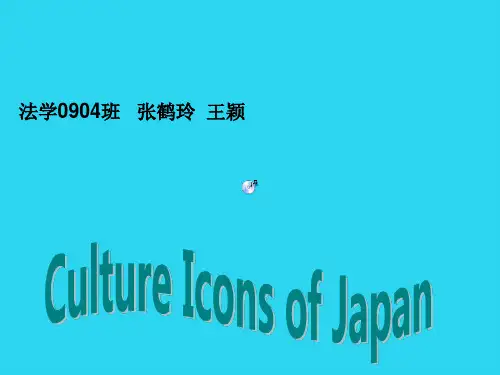
In Japanese, the cherry is called ”Sakura”, which is generally believed to be a corruption of the word “ Sakura” (blooming ) from the name of Princess KonoHana-Sakura-Hime.
There is often a misconception(误解) by some that Geisha are prostitutes(娼妓), but nothing could be further from the truth Geisha are refined and cultured girls and woman who are highly trained in a variety of traditional skills. Besides playing Shamisen ( 三弦琴), singing, and dancing, the Geisha perform the Japanese tea ceremony, and are well versed(精通的) in the art of conversation. Many learn to speak English to entertain Western guests.
This Mt. Fuji is beautiful and magic, isn’t it?
Many learn to speak English to entertain Western guests. In Japanese, the cherry is called ”Sakura”, which is generally believed to be a corruption of the word “ Sakura” (blooming ) from the name of Princess Kono-Hana-Sakura-Hime. Maneki Neko Located almost in the center of the country, this well-proportioned cone-shaped mountain has been worshiped by the Japanese people since ancient times, and is a well-known symbol of Japan in other countries. The scroll he carries bears the congenial(和蔼的) message. With a right paw raised he welcomes wealth or luck. Maneki Neko 法学0904班 张鹤玲 王颖 There is often a misconception(误解) by some that Geisha are prostitutes(娼妓), but nothing could be further from the truth Geisha are refined and cultured girls and woman who are highly trained in a variety of traditional skills. Welcoming Cat, Lucky Cat, Money cat , Fortune Cat Many learn to speak English to entertain Western guests. With economic, cultural and religious influence from neighboring Asian states, Japan has produced a unique culture of its own. 法学0904班 张鹤玲 王颖 法学0904班 张鹤玲 王颖 Located almost in the center of the country, this well-proportioned cone-shaped mountain has been worshiped by the Japanese people since ancient times, and is a well-known symbol of Japan in other countries. “Maneki Neko” means “beckoning(召唤) cat” in the Japanese language. With economic, cultural and religious influence from neighboring Asian states, Japan has produced a unique culture of its own. Fuji, however, soars into the sky alone.
日本传统介绍英文作文
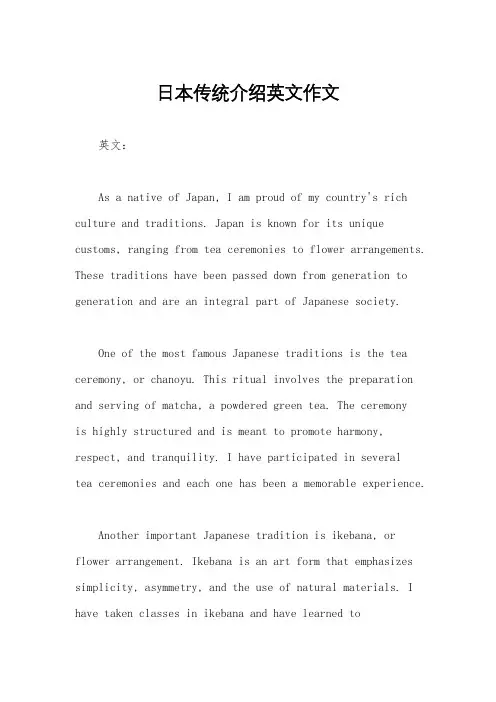
日本传统介绍英文作文英文:As a native of Japan, I am proud of my country's rich culture and traditions. Japan is known for its unique customs, ranging from tea ceremonies to flower arrangements. These traditions have been passed down from generation to generation and are an integral part of Japanese society.One of the most famous Japanese traditions is the tea ceremony, or chanoyu. This ritual involves the preparation and serving of matcha, a powdered green tea. The ceremonyis highly structured and is meant to promote harmony, respect, and tranquility. I have participated in severaltea ceremonies and each one has been a memorable experience.Another important Japanese tradition is ikebana, or flower arrangement. Ikebana is an art form that emphasizes simplicity, asymmetry, and the use of natural materials. I have taken classes in ikebana and have learned toappreciate the beauty of arranging flowers in a way that highlights their natural form.In addition to these well-known traditions, there are many other aspects of Japanese culture that are worth exploring. For example, Japanese cuisine is renowned forits freshness and attention to detail. From sushi to ramen, there is something for everyone to enjoy.Overall, I believe that Japan's traditions are an important part of our cultural heritage and should be celebrated and preserved for future generations.中文:作为日本人,我为我的国家丰富的文化和传统感到自豪。
介绍日本历史文化英语作文
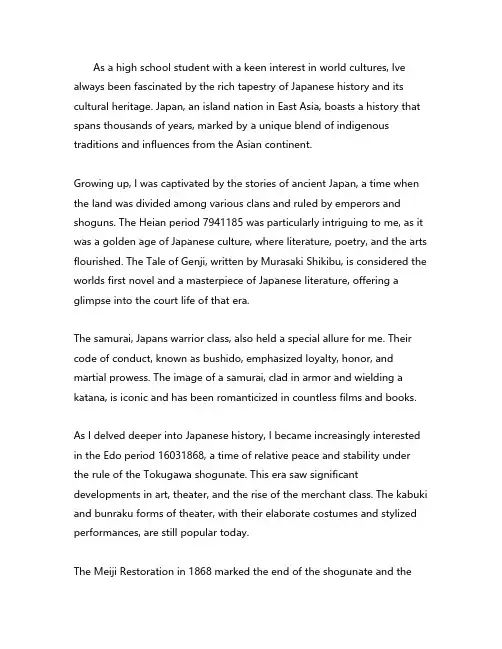
As a high school student with a keen interest in world cultures, Ive always been fascinated by the rich tapestry of Japanese history and its cultural heritage. Japan, an island nation in East Asia, boasts a history that spans thousands of years, marked by a unique blend of indigenous traditions and influences from the Asian continent.Growing up, I was captivated by the stories of ancient Japan, a time when the land was divided among various clans and ruled by emperors and shoguns. The Heian period 7941185 was particularly intriguing to me, as it was a golden age of Japanese culture, where literature, poetry, and the arts flourished. The Tale of Genji, written by Murasaki Shikibu, is considered the worlds first novel and a masterpiece of Japanese literature, offering a glimpse into the court life of that era.The samurai, Japans warrior class, also held a special allure for me. Their code of conduct, known as bushido, emphasized loyalty, honor, and martial prowess. The image of a samurai, clad in armor and wielding a katana, is iconic and has been romanticized in countless films and books.As I delved deeper into Japanese history, I became increasingly interested in the Edo period 16031868, a time of relative peace and stability under the rule of the Tokugawa shogunate. This era saw significant developments in art, theater, and the rise of the merchant class. The kabuki and bunraku forms of theater, with their elaborate costumes and stylized performances, are still popular today.The Meiji Restoration in 1868 marked the end of the shogunate and thebeginning of Japans rapid modernization. This period saw Japan embracing Western technology and ideas while maintaining its cultural identity. The transformation was nothing short of remarkable, as Japan emerged as a world power in a matter of decades.Culturally, Japan is a treasure trove of unique traditions and practices. The tea ceremony, or chado, is a ritualized preparation and presentation of matcha, a powdered green tea. It is more than just a beverage it is a choreographed art form that embodies harmony, respect, purity, and tranquility.Festivals, or matsuri, are an integral part of Japanese life, celebrating everything from harvests to local patron saints. The Gion Matsuri in Kyoto, with its grand procession of floats and participants in traditional attire, is a spectacle that transports you to another time.Japanese cuisine is another aspect of its culture that has captured the worlds attention. Sushi, ramen, tempura, and wagashi traditional sweets are just a few examples of the diverse and flavorful dishes that reflect the countrys culinary artistry.The Japanese language itself is a reflection of the countrys history, with a writing system that includes kanji Chinese characters, hiragana, and katakana. The complexity and beauty of the language are a testament to the depth of Japanese culture.In recent years, Japanese pop culture has gained global popularity, withanime and manga becoming beloved forms of entertainment. The creativity and storytelling in these mediums have introduced countless people to Japanese culture and values.My fascination with Japans history and culture has led me to study the language and plan a visit to experience its traditions firsthand. From the ancient temples of Kyoto to the bustling streets of Tokyo, I am eager to immerse myself in the rich tapestry of Japanese life.In conclusion, Japans history and culture offer a wealth of knowledge and inspiration. The countrys ability to blend tradition with modernity, while maintaining a strong sense of identity, is truly remarkable. As a high school student, I am grateful for the opportunity to learn about and appreciate the depth and diversity of Japanese culture.。
日本文化英语作文
日本文化英语作文Title: Exploring Japanese Culture: A Journey Through Tradition and Innovation。
Japan, a land rich in tradition and innovation, captivates the imagination with its vibrant culture. From ancient rituals to cutting-edge technology, the essence of Japan permeates through its art, cuisine, festivals, and everyday life. Let's embark on a journey to explore the multifaceted aspects of Japanese culture.One of the most striking features of Japanese cultureis its deep-rooted tradition, which is evident in various aspects of daily life. For instance, the tea ceremony, known as "Sadō" or "Chanoyu," is not merely about drinking tea but a profound ritual that embodies harmony, respect, purity, and tranquility. Participants engage in meticulous movements, adhering to prescribed etiquette, creating a serene atmosphere where every gesture holds meaning.Another aspect of Japanese tradition is the art of Ikebana, or flower arrangement. Originating from the Buddhist practice of offering flowers to the spirits, Ikebana evolved into a sophisticated art form characterized by minimalist aesthetics and a deep appreciation for nature. Each arrangement is meticulously crafted to evoke harmony and balance, reflecting the seasonal beauty of Japan's flora.Moreover, traditional Japanese architecture, with its emphasis on simplicity, natural materials, and harmony with the environment, showcases the timeless elegance of Japanese design. From the serene temples of Kyoto to the intricate wooden machiya houses of old Kyoto, everystructure tells a story of craftsmanship and reverence for the surrounding landscape.While tradition forms the bedrock of Japanese culture, Japan is also a hub of innovation and modernity. Thecountry's technological prowess is globally renowned, with groundbreaking advancements in robotics, electronics, and transportation. Tokyo, a bustling metropolis, pulsates withenergy and innovation, reflecting Japan's status as a leader in technology and design.The concept of "Wa" or harmony permeates Japanese society, manifesting in various forms, including the efficient and orderly public transportation system, the meticulous craftsmanship of Japanese products, and the seamless blend of tradition and modernity in everyday life. Whether it's the sleek design of a Shinkansen bullet train or the precision engineering of a Japanese kitchen knife, the pursuit of harmony is evident in every aspect of Japanese innovation.Japanese pop culture, often referred to as "Cool Japan," has also garnered global attention, influencing trends in fashion, entertainment, and cuisine. From the colorful world of anime and manga to the catchy tunes of J-pop music, Japanese pop culture reflects the dynamic and eclectic nature of contemporary Japan.Cuisine is another integral aspect of Japanese culture, renowned for its exquisite flavors, meticulous preparation,and artistic presentation. From delicate sushi and sashimi to hearty bowls of ramen and savory yakitori skewers, Japanese cuisine offers a culinary journey that tantalizes the taste buds and nourishes the soul.Furthermore, traditional festivals, known as "Matsuri," showcase Japan's vibrant cultural heritage and community spirit. From the dazzling floats of the Gion Matsuri in Kyoto to the breathtaking fireworks of the Sumida River Fireworks Festival in Tokyo, these celebrations bring people together to honor tradition, celebrate the seasons, and create lasting memories.In conclusion, Japanese culture is a tapestry woven with threads of tradition and innovation, creating a unique blend of ancient wisdom and modern dynamism. From the serene rituals of the tea ceremony to the bustling streets of Tokyo, Japan's rich cultural heritage continues to inspire and captivate people around the world. As we delve deeper into the heart of Japanese culture, we discover not only its timeless traditions but also its boundless creativity and spirit of innovation.。
最新日本文化的介绍(英语)
ethnic group
The Japanese nation basically consists of the Yamato, the Ryukyu, and the Ainu.
Yamato constitutes the main body of the Japanese nation, accounting for about 99.9% of the current total population of Japan
Agricultural productie development of commodity economy promotes market prosperity
It is a turbulent social transition period, and the divided country became a unity.
In 1868-1890
In 1914-1918 In 1939-1945
After the war
Economy
TOYOTA HONDA
Economy
Economy
Agriculture
Only 12% of Japan‘s land can grow food. Japanese agriculture is a highly protected industry , and because of the lack of land and labor, they use high-tech farming. Unit land production is the world's largest.
1. Located on the east coast of the Asian continent.
日本文化的介绍(英语) PPT
Mount Fuji
Cherry Blossom
Japanese Ramen
Sushi
Japanese Ramen
Sushi
kimono
geisha
Uniforms
• Largest anime country. • Every year 200 animations. • 60% of the world’s animations.
Animation has become one of the pillars of Japan’s economy
People profile
In 1868-1890 In 1914-1918 In 1939-1945
After the war
Economy
TOYOTA HONDA
大家有疑问的,可以询问和交流
可以互相讨论下,但要小声点 9
Economy
Economy
Agriculture
Only 12% of Japan‘s land can grow food. Japanese agriculture is a highly protected industry , and because of the lack of land and labor, they use high-tech farming. Unit land production is the world's largest.
In 646 In 1185 In 1336
In 1467—1585
History
This led to the industrialization of Japan, gradually becoming a world power, it’s an important turning point in Japan's recent history
日本的文化英语作文
日本的文化英语作文Japanese culture is a fascinating mosaic of ancient traditions and modern innovations. It is a reflection of the Japanese people's deep respect for their heritage and their embrace of new ideas. From its rich artistic heritage to its unique social customs, Japanese culture is deeply rooted in the values of harmony, respect, and perseverance.One of the most striking aspects of Japanese culture is its traditional arts. These include practices such as calligraphy, painting, pottery, and origami. Calligraphy, known as shodo in Japan, is not only a form of artistic expression but also a means of practicing discipline and focus. Japanese painting, with its delicate brushstrokes and use of natural motifs, showcases the country's appreciation for the beauty of nature. Pottery, particularly the kiln techniques used in regions like Arita and Seto, has a long history and is cherished for its beauty and functionality. Origami, the art of folding paper, is both a traditional pastime and a significant part of Japanese cultural events.Japanese cuisine, known as washoku, is world-renowned for its delicate flavors, intricate presentation, and emphasis on seasonal ingredients. Dishes such as sushi, tempura, and ramen have gained global popularity, reflecting the influence of Japanese cuisine on world food cultures. The art of tea ceremony, orchanoyu, is another important aspect of Japanese culture, symbolizing harmony, respect, and tranquility.Social customs in Japan are characterized by a strong sense of etiquette and respect. The concept of omotenashi, or hospitality, is deeply ingrained in Japanese society. This is evident in the attention to detail in service industries, the importance of gift-giving, and the practice of bowing as a form of greeting. The Japanese people's respect for elders and their commitment to maintaining harmony in social interactions are also notable aspects of Japanese culture.In recent years, Japanese culture has also influenced global trends in fashion, animation, and technology. Japanese street fashion, with its bold andinnovative styles, has captured the imagination of fashion enthusiasts worldwide. Anime and manga, Japanese forms of graphic storytelling, have become global phenomena, introducing Japanese cultural elements to audiences far and wide.In conclusion, Japanese culture is a unique blend of tradition and modernity. Its rich heritage and innovative practices continue to inspire and captivate people around the world. The Japanese people's dedication to preserving their cultural traditions while embracing new ideas is a testament to the dynamic and fascinating nature of Japanese culture.中文翻译:日本文化是一幅由古老传统和现代创新构成的迷人马赛克。
- 1、下载文档前请自行甄别文档内容的完整性,平台不提供额外的编辑、内容补充、找答案等附加服务。
- 2、"仅部分预览"的文档,不可在线预览部分如存在完整性等问题,可反馈申请退款(可完整预览的文档不适用该条件!)。
- 3、如文档侵犯您的权益,请联系客服反馈,我们会尽快为您处理(人工客服工作时间:9:00-18:30)。
e t i q u e t
d i n i n g
a n d
k i o n o
t r d i t i
J a p a n e s
m a
t
e
o
n a
e
l
content
What Kimono Is The Kimono Pattern Parts
Kimono in History
Kimono=着物(きもの)
What Is Kimono
Kimono means something to wear in Japanese. Specifically, kimono refers to traditional Japanese clothes (kimono dresses).
The Kimono Pattern Parts
Jomon Period (Before 300 AD) 縄文時代
Yamato Period (300-550-710 A.D.)飛鳥時代
Nara Period (710-792 A.D.) 奈良時代
Heian Period (792-1192 A.D.) 平安時代
Kimono in History
The illustration to the right shows how kimono design has changed over the centuries.
From the primitive Jomon(縄文) period through the Yamato(大和), Asuka(飛鳥), Nara (奈良), Heian(平安), Muromachi(室町), and Edo(江戸) periods, factors including climate, life and customs of the Imperial court, laws, the development of skills in weaving and dyeing, and the availability of materials have influenced the style of Japanese clothing. Today , 1200 years later, the Imperial household still uses the costumes of the Heian period (平安時代)for the formal occasions of coronations and weddings.
武官束帯(ぶかんそくたい)
采女(うねめ)
十二単(じゅうにひとえ): 宫廷妇女的一种礼服
水干(すいかん)
汗衫(かざみ)
Muromachi Period (1192-1573 A.D.) 室町時代
Edo Period (1601-1867 A.D.) 江戸時代
